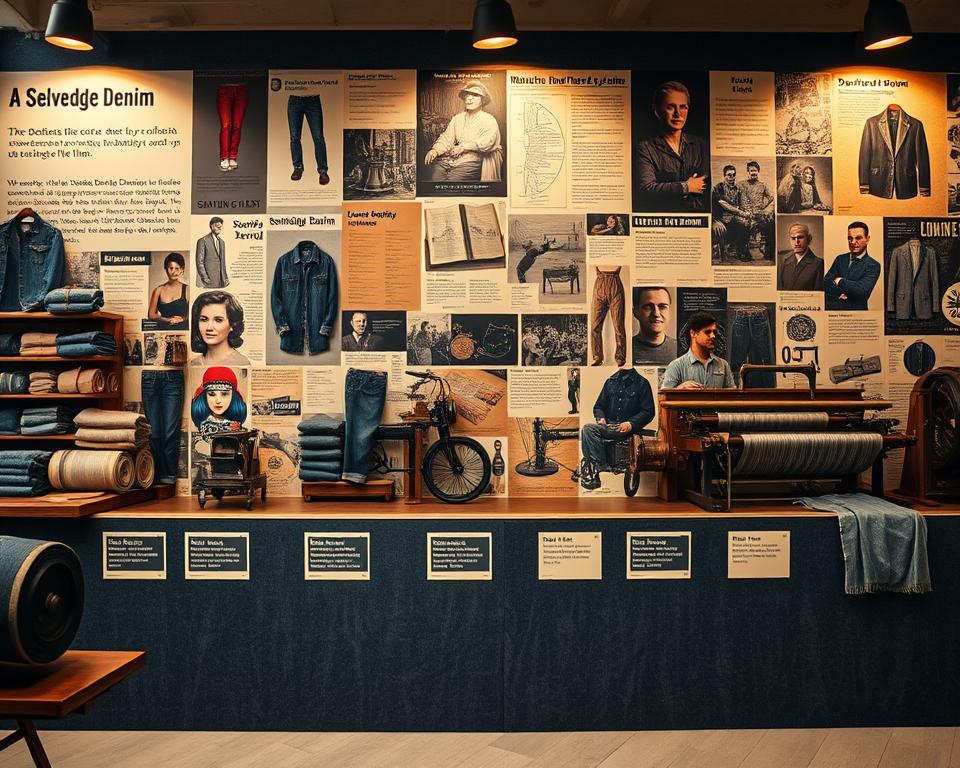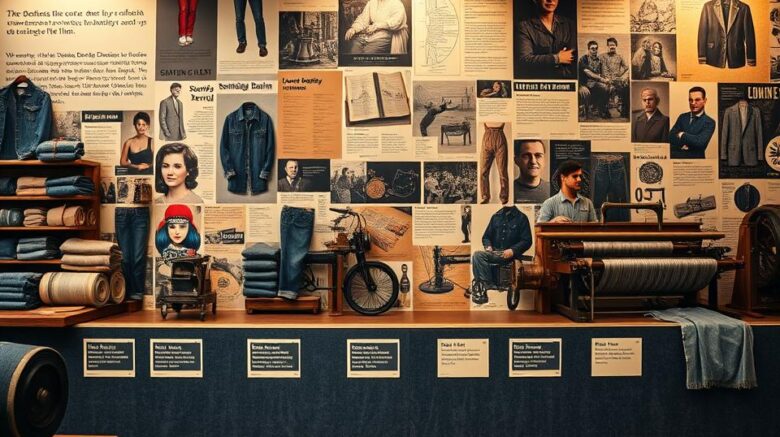The Ultimate Guide for Superior denim Selvedge Fabric
Ever questioned why some pants feel like they’re built for endurance the ages? It’s all about the materials and artistry. Consider the rising trend of high-end selvedge. It’s not merely ordinary material—it exemplifies quality and legacy.
Today, increasingly more individuals are opting for these everlasting fabrics for their robustness and traditional ewingfly denim charm. Be it that you are a DIY sewist or a denim enthusiast, there’s a unique quality about employing top-grade natural fiber and thread. It isn’t solely concerned with making pants; it involves fashioning something that tells a story.
Here at Core Fabrics, we’ve curated a range of 14.25oz certified organic cotton and elastic variants. Such textiles are ideal for a spectrum ranging from raw trousers to designer jacket designs. Ready to explore the world of premium fabrics? Let us delve in.
Understanding Denim Selvedge Fabric?
Why do certain jeans distinguish themselves with their unique, naturally edged seams? The key resides in the selvedge denim, a high-quality material known for its enduring strength and vintage charm. Differing from standard textiles, this fabric is crafted with classic methods that have endured through ages.
The Definition of Selvedge Denim
Selvedge denim is produced via old-style shuttle looms, which yield slender widths of about 30-35 inches. They intertwine the textile in a manner that ensures self-finished seams, often highlighted by a signature red line. Such a process guarantees the textile is firmly crafted and exceptionally sturdy.
Modern looms, on the other hand, yield broader material but lack the equivalent of skill. Minor flaws in selvedge, like twists in the leg or irregular surfaces, are embraced as features of its character. This approach, termed “wabi-sabi”, exalts the aesthetic of inherent flaws.
Production of Selvedge Denim
The creation of selvedge denim entails a exacting process. These looms interlace the weft thread back and forth, resulting in a dense and robust textile. Unlike modern methods with new-age looms, which emphasize quick production and efficiency over quality.
Brands like Karson Denim maintain vintage Japanese craft practices from the 1990s. They intentionally include flaws to preserve the genuineness of the textile. Every item is assessed on a four-point system, guaranteeing it fulfills the top criteria of superiority.
| Feature | Selvedge Denim | Modern Denim |
|---|---|---|
| Span | 30-35 inches | 60+ inches |
| Fabrication Method | Traditional Shuttle | Modern Loom |
| Surface | Irregular, Flawed | Uniform |
| Sturdiness | Exceptional | Average |
“The beauty of selvedge resides in its natural irregularities—each flaw tells a story artistry and heritage.”
The Background of Selvedge Denim
Evolving from simple roots to global acclaim, the tale of these fabrics is vibrant and moving. What started as rugged attire in the 17th-century France has become a symbol of everlasting fashion and artistry.
Historical Roots
The origin of this textile reaches back to Nîmes, France, where it was known as “serge de Nîmes.” First intended for laborers, it was made from robust cotton and stitching. Its strength made it a favorite among workers during the historic Gold Rush.
In the 20th century, it had transformed into a staple for pants. The closure of the Cone Mills White Oak factory marked a turning point. This shift paved the way for Japanese artisans to revive classic fabric-making practices.

Advancements in Production
After World War II, Japan embraced old-school American culture. Skilled workers restored classic looms to produce true reproductions. This dedication to quality guaranteed the perseverance of selvedge as a niche product.
Today, breakthroughs from Italy and Turkey have launched eco-friendly blends and flexible selections. These improvements have enhanced the allure of this classic fabric. Here at Core Fabrics, we source globally, from Montréal to Asia, to bring you the top-notch quality.
“The history of selvedge is a celebration of the perennial merit of excellence and heritage.”
Reasons to Select Selvedge Denim?
Why does selvedge denim shine in the realm of top-tier textiles? Its unique qualities and exceptional longevity make it a favorite among aficionados and creatives alike. Be it that you are sewing pants or a tailored jacket, this textile offers a blend of classic methods and modern appeal.
Distinctive Attributes of Selvedge
Selvedge denim is renowned for its firm interlacing, which boosts tear resistance and fade potential. In contrast to common fabrics, denim selvedge fabric is fashioned using classic shuttle looms, resulting in a denser and exceptionally sturdy fabric. Such a process guarantees that all products boast a singular finish and personality.
Key features include:
- Textured, firm raw denim offers a contrast to softened, pre-washed stretch fabrics.
- Sanforization stabilizes the fabric for consistent measurements, while natural variants entail a dynamic fitting process.
- Weight options range from 9.5oz Eco Finish to 14.25oz Organic, meeting diverse applications.
Robustness and Endurance
One of the key attributes of selvedge denim is its long life. The firm interlacing boosts robustness while enabling distinctive color fades over time. This establishes it as a valuable investment for those looking for timeless pieces.
Important aspects:
- 12-14oz weights are ideal for structured jackets and jeans that soften with age.
- Opt for the 14.25oz True Indigo for traditional jean lifespan.
- Sustainable variants such as recycled cotton combined with indigo blends enhance eco-friendliness.
Within our range at Core Fabrics, diverse choices cater to distinct demands. Whether untreated or sanforized, every item is made to provide outstanding quality and performance.
Selvedge Denim vs. Wide Denim
For making robust and fashionable apparel, the selection of fabric is pivotal. Among the prevalent selections are selvedge and wide denim, each with unique characteristics. Understanding their differences can help you choose the best option for your project.
Contrasting Weave Techniques
Selvedge denim is crafted with classic shuttle looms, resulting in slim widths of 30-35 inches. This herringbone denim material method forms secure finishes, often accented with a signature red line. In contrast, wide denim is produced using modern projectile looms, producing widths of 60 inches or more.
Shuttle looms are slower, producing about 3 meters per minute, while contemporary projectile looms achieve up to 30m per minute. The variance in production speed affects both the expense and the finish of the end result.
Advantages and Disadvantages
Selvedge denim is renowned for its high-end construction and robustness. Its limited breadth suits it well for projects where defined edges and detail work are sought. However, it can be more expensive, averaging $23 per meter.
Wide denim is budget-friendly, ranging at $8 per half-meter. Its expansive dimension reduces waste, making it suitable for big-scale works like upholstery. However, it does not feature the unique edge finish of selvedge.
| Feature | Selvedge Denim | Wide Denim |
|---|---|---|
| Span | 30-35 inches | 60+ inches |
| Method | Classic Shuttle Loom | Modern Projectile |
| Output | 3m per minute | 30m/min |
| Expense | $23/meter | $8 per half-meter |
When precise, structured edges are required—as in Grainline Thayer jackets—selvedge wins out. For larger projects, wide denim offers better value and efficiency. Consider your project needs to make the best decision.
Working with Selvedge Denim
Utilizing superior fabrics can transform your sewing endeavors. Whether you’re crafting jeans, blazers, or skirts, grasping fabric quantities, proper sewing methods, and maintenance guarantees a polished result. We will examine how to make the most of this timeless material.
Material Requirements for Jeans and Jackets
It is essential to compute the correct fabric amount when designing your creation. For men’s jeans, you’ll need about 3-3.3 yards, accounting for potential defects and shrinkage. Trucker-style jackets generally demand about 3.3 yards, while skirts require only 2 yards.
Smart pattern positioning minimizes the impact of defects. Rather than avoiding imperfections, incorporate them into your pattern for distinctive style.
| Project | Required Yardage |
|---|---|
| Male Jeans | 3-3.3 yards |
| Trucker-Style Jacket | 3.3 yards |
| Skirt Item | 2 yards |
Tips for Sewing and Care
Employing proper equipment and methods leads to an impeccable finish. Select #70 to 110 pins and foot accessories made for robust textiles. Gütermann rPET thread works well for contrasting stitches.
Consider these extra tips:
- Use a tailor’s clapper for sharp creases without shine.
- Core Fabrics provides denim kits with topstitch thread, rivets, and 9mm buttons for that expert touch.
- For structured edges, like those in jackets, selvedge is the preferred choice.
Maintaining your pieces properly increases their longevity. Wash sparingly and air dry to maintain the material’s integrity. Adhering to these practices will sustain your creations for years.
The Final Word
Crafting with premium materials isn’t just about durability—it’s about creating something with character. Selvedge denim embodies this principle, blending craftsman allure with robust strength. Be it crafting jeans or tailoring a refined jacket, each stitch narrates a tale.
At Core Fabrics, we make it easy to explore your creativity. Experience our swatch service to gauge texture and weight prior to purchase. Furthermore, take advantage of free shipping for orders above $150 USD in North America.
Future trends in cotton textiles include sustainable blends and retro washes. Such innovations provide novel methods for infusing eco-consciousness and fashion into your closet.
Eager to explore top-tier textiles? Begin your journey now and appreciate the merit of intentional crafting. Your subsequent creation may well become an enduring classic.
